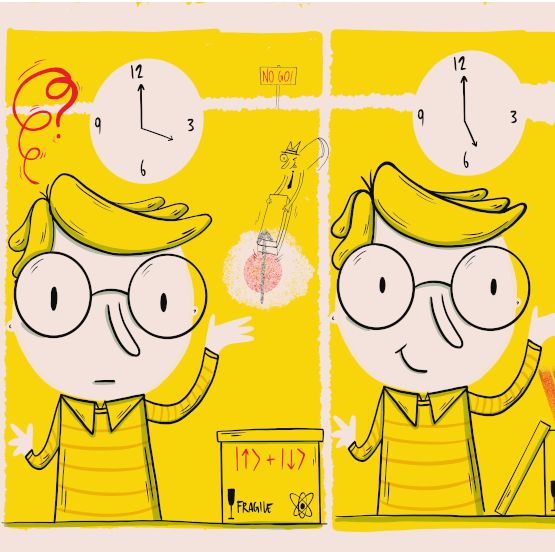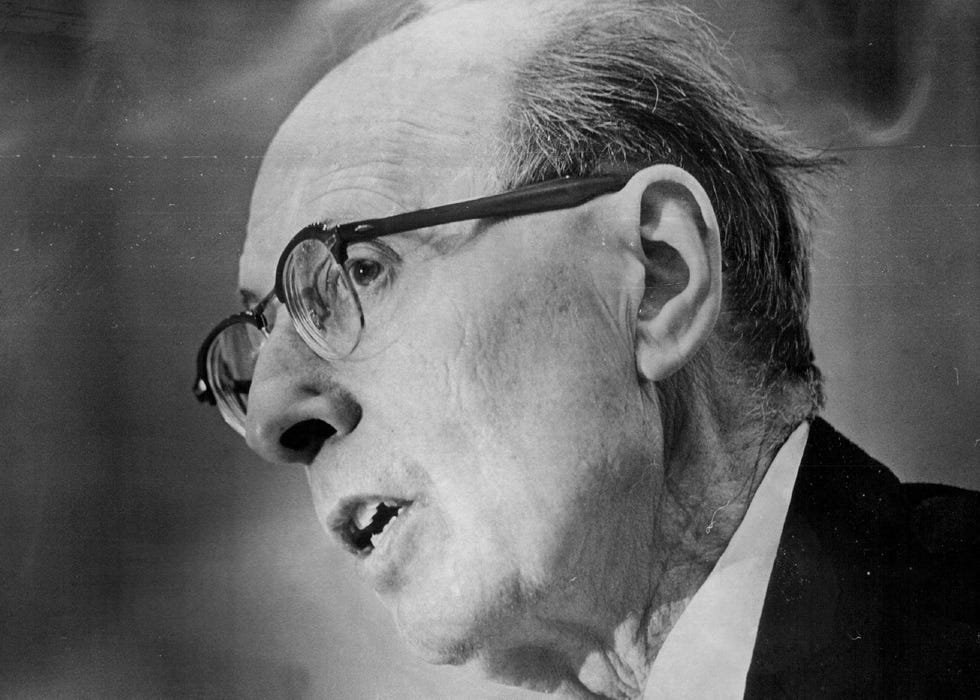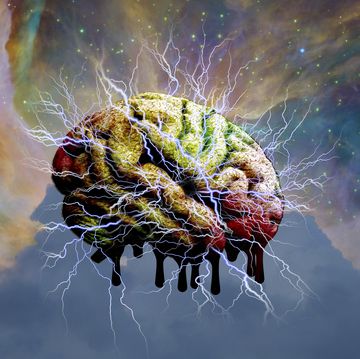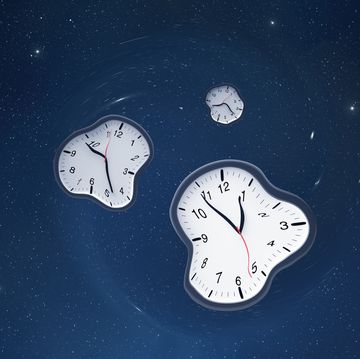- Wigner's Friend is a paradox in quantum physics that describes the states of two people: one conducts an experiment, and the other observes that first person.
- Traditionally, the thought experiment shows that you can't take another person's observations at face value—your reality isn't necessarily theirs.
- Researchers from Austria and Canada have proven that it's more complicated than that: you can't even trust your own observations from the past.
If you read this story, can you be sure that it really exists? To you, the reader, there is a webpage with text right before your eyes, perhaps on a laptop, or maybe on a smartphone. Typically, that's enough proof that these words live on somewhere in the ether.
But let's assume that you're in a "quantum superposition," a fancy physics term that means your reading experience exists in a few separate quantum states at once—other timelines, or dimensions, if you will. In one scenario, you're seeing this story; in another, the URL string brings up a 404 error.
Right now, you're in the first quantum state, reading; that is, you're perceiving a definite outcome. Meanwhile, an outside observer that is watching you can appreciate both possibilities—that you're reading a story, and that you're looking at a broken link—putting your realities in opposition. You see one thing, that observer sees both things.
This paradox is well-known in physics circles as the Wigner's Friend thought experiment, and it supposedly proves that you cannot assume the knowledge of other observers as your own. But a team of researchers from the University of Vienna, the Austrian Academy of Sciences, and the Ontario-based Perimeter Institute for Theoretical Physics have proven that the full story is even more complicated: you cannot even trust your own eyes.
"In the present work we have proved that one's own knowledge from the past cannot be used in the present either," Caslav Brukner, a professor of physics at the University of Vienna, and one of the scientists involved in the new research, tells Popular Mechanics. "This is the case for the friend, if between two observations an intervention (measurement) of Wigner has taken place."
In our webpage example, that means you can't assume that just because this story popped up in your browser in the past, that it will again—assuming the whole exercise is a version of the Wigner's Friend thought experiment. In other words, you can't even trust that your own observations in the past will hold true if you try that thing again in the present.
Let's break down what's going on here, and what this means for our whole conception of reality (and quantum physics) as we know it.
The "Measurement Problem" in Quantum Physics
Without Schrödinger's Cat—one of the great paradoxes in quantum physics—we would not have Wigner's Friend. That thought experiment, which Austrian-Irish physicist Erwin Schrödinger concocted in 1935 during a conversation with Albert Einstein, describes a situation wherein a hypothetical cat can be considered both dead and alive as a radioactive isotope sits inside.
The cat is in a state of quantum superposition, because the subatomic particle may or may not decay while the cat is inside, and we cannot see the microscopic particle decay with our own eyes. In other words, we can't know if the cat is alive or dead, if the particle decayed or remained intact, until we open the box to observe the results of the experiment: a living or a dead cat. Only then do we have a definite result.
Schrödinger came up with the thought experiment, more or less in jest (he called it a "quite ridiculous" scenario) to prove a point. In quantum mechanics, this issue of observation is called the "measurement problem." When a cat—or perhaps a subatomic particle—is in a state of quantum superposition, it's oscillating between possibilities; there is no 0-1 binary to operate on. In other words, quantum physics doesn't allow for deterministic, black-and-white results. A cat isn't just alive or dead, a subatomic particle isn't just matter or antimatter. Rather, quantum theory necessitates probabilistic outcomes that live between 0 and 1, so to speak. It's a spectrum of possibilities.
However, when a scientist makes an observation, like looking inside the box to check on kitty, they will find the system in a definite state: 1, or 0, dead or alive. That flies in the face of quantum physics, because results are probabilistic, not definite. This "Copenhagen interpretation" states that a system has infinite outcomes...up until the point that you take a measurement.
So in reality, if we measure the system (that is, make an observation), we're impacting future measurements, too, since we're basing new observations on a past, definite outcome. Put another way, observing a quantum system fundamentally changes the system. That's in contrast to classical physics, which allows you to "define a state of a system at any later time, with respect to a state at any earlier time."
How do we know that? Quantum physics experiments have shown that subatomic particles really do act differently when they're observed—you can't determine a particle's velocity, since it's always in motion, until you measure it. The double-slit experiment is one famous example with photons.
What Is Wigner's Friend?
In 1961, theoretical physicist Eugene Wigner proposed a new thought experiment to complicate the Schrödinger's Cat paradox, further pushing on the measurement problem in quantum physics. It goes like this:
You're friends with Wigner, and you agree to perform a measurement of a quantum system for him in a laboratory. Let's say it's a Schrödinger's Cat experiment. Before you go in and observe the cat, it's in a state of quantum superposition, as described above. But when you make your observation, checking to see if the cat is alive or dead, you'll find one of the two binary outcomes: dead or alive.
At the same time, Wigner is modeling your experiment from outside the laboratory door. He knows that you'll find one of those two scenarios; now, your experiment with the cat is in a state of quantum entanglement with Wigner. Until he records your observations, his observation is in flux. Therefore, it's not until Wigner finds out your results that they become real, definite.
But then that's the whole paradox: If you found the cat dead, and your observations impact the experiment per the Copenhagen interpretation, did it die when you found it, or when Wigner consciously recorded those results? Wigner, after all, could watch you observing two different possibilities at once.
As Brukner, the physicist, explains in his new work, published earlier this year in the journal Communications Physics:
"After the friend's measurement has taken place, we are in a counterintuitive situation where Wigner describes the friend in a quantum superposition of observing two different outcomes, while from the friend's perspective a definite outcome must be perceived."
What Does the New Research Propose?
Clearly, there's going to be some trust issues between you and Wigner in this scenario. So, Brukner's team set out to determine if an observer can trust what they see while taking measurements in a quantum superposition, and if they could use that data to make predictions about future measurements. In other words, the team took a closer look at the limitations of the Wigner's Friend thought experiment in the world of quantum mechanics.
Upon analysis, Brukner says that the Wigner's Friend thought experiment would have to break at least one of the following three assumptions to hold true:
1) The friend's perception has a reality that persists over time. This means that we can consider both knowledge from the past, and knowledge from the present, as real or coexistent. "Note that in normal situations, even if all our perceptions [have] taken place in the present, we can still assume that what happened yesterday is real, and combine that knowledge with what we acquire now."
In mathematics, this is called "joint probability," and it's a statistical measure that explains the likelihood that two events will occur at once at the same time. "As an example of the joint probability, we might start from roulette. There is a probability that the ball will stop on a red field or a black field," Brukner explains. "Similarly, there is a probability that it will stop on an even or odd number. However, there is also a joint probability that the field is both red and the number is even, for example."
2) Quantum theory is empirically correct. This is the idea that Wigner's predictions, based on his application of quantum theory, are empirically correct. "This could be justified by the fact that he describes the friend as a quantum system, and hence has a more "detailed" description of the physical situation than the friend," Brukner says.
3) You can't change the rules of quantum physics to make the first condition true. This is the idea that, if assumption 1 is correct, "we do not change the quantum formalism to calculate the probability of the friend's presupposed perceptions over time," Brukner says.
This stuff is extremely heady. So what does it all mean for you, sitting here, reading this story on a computer or a tablet, not knowing if you can trust your own eyes, or trust that what you're reading is even true?
Brukner says that the main takeway is that, "not even the friend herself should assume that her outcome observed in the past, and her outcome observed in later measurements, both coexist as real."
In other words, you can't trust that just because you saw this story on Sunday, that you'll see it again on Monday. But you also can't assume that just because you didn't see the story on Monday, that you won't see it again on Tuesday.
So yeah, there's basically no such thing as objective reality.















